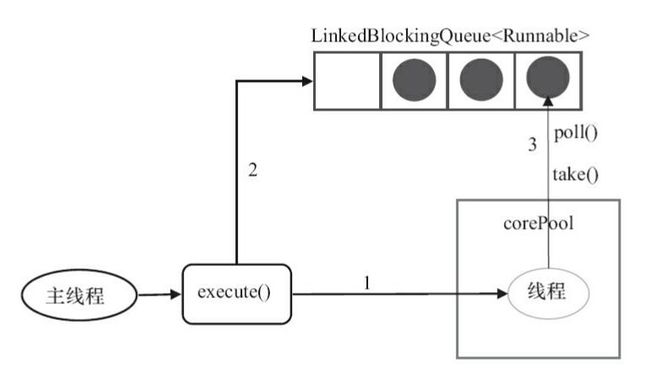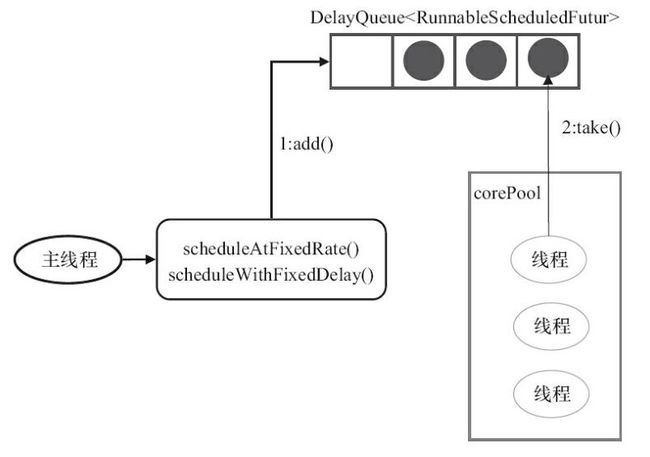Java面试通关手册(Java学习指南,欢迎Star,会一直完善下去,欢迎建议和指导):https://github.com/Snailclimb/Java_Guide
历史优质文章推荐:
Java并发编程指南专栏
分布式系统的经典基础理论
可能是最漂亮的Spring事务管理详解
面试中关于Java虚拟机(jvm)的问题看这篇就够了
目录:
[TOC]
思维导图源文件+思维导图软件关注微信公众号:“Java面试通关手册” 回复关键字:“Java多线程” 免费领取。
一 使用线程池的好处
线程池提供了一种限制和管理资源(包括执行一个任务)。 每个线程池还维护一些基本统计信息,例如已完成任务的数量。
这里借用《Java并发编程的艺术》提到的来说一下使用线程池的好处:
- 降低资源消耗。通过重复利用已创建的线程降低线程创建和销毁造成的消耗。
- 提高响应速度。当任务到达时,任务可以不需要的等到线程创建就能立即执行。
- 提高线程的可管理性。线程是稀缺资源,如果无限制的创建,不仅会消耗系统资源,还会降低系统的稳定性,使用线程池可以进行统一的分配,调优和监控。
##二 Executor 框架
2.1 简介
Executor 框架是Java5之后引进的,在Java 5之后,通过 Executor 来启动线程比使用 Thread 的 start 方法更好,除了更易管理,效率更好(用线程池实现,节约开销)外,还有关键的一点:有助于避免 this 逃逸问题。
补充:this逃逸是指在构造函数返回之前其他线程就持有该对象的引用. 调用尚未构造完全的对象的方法可能引发令人疑惑的错误。
2.2 Executor 框架结构(主要由三大部分组成)
####1 任务。
执行任务需要实现的Runnable接口或Callable接口。
Runnable接口或Callable接口实现类都可以被ThreadPoolExecutor或ScheduledThreadPoolExecutor执行。
两者的区别:
Runnable接口不会返回结果但是Callable接口可以返回结果。后面介绍Executors类的一些方法的时候会介绍到两者的相互转换。
####2 任务的执行
如下图所示,包括任务执行机制的核心接口Executor ,以及继承自Executor 接口的ExecutorService接口。ScheduledThreadPoolExecutor和ThreadPoolExecutor这两个关键类实现了ExecutorService接口。注意: 通过查看ScheduledThreadPoolExecutor源代码我们发现ScheduledThreadPoolExecutor实际上是继承了ThreadPoolExecutor并实现了ScheduledExecutorService ,而ScheduledExecutorService又实现了ExecutorService,正如我们下面给出的类关系图显示的一样。
ThreadPoolExecutor类描述:
//AbstractExecutorService实现了ExecutorService接口
public class ThreadPoolExecutor extends AbstractExecutorServiceScheduledThreadPoolExecutor类描述:
//ScheduledExecutorService实现了ExecutorService接口
public class ScheduledThreadPoolExecutor
extends ThreadPoolExecutor
implements ScheduledExecutorService Future接口以及Future接口的实现类FutureTask类。
当我们把Runnable接口或Callable接口的实现类提交(调用submit方法)给ThreadPoolExecutor或ScheduledThreadPoolExecutor时,会返回一个FutureTask对象。
我们以AbstractExecutorService接口中的一个submit方法为例子来看看源代码:
public Future submit(Runnable task) {
if (task == null) throw new NullPointerException();
RunnableFuture ftask = newTaskFor(task, null);
execute(ftask);
return ftask;
} 上面方法调用的newTaskFor方法返回了一个FutureTask对象。
protected RunnableFuture newTaskFor(Runnable runnable, T value) {
return new FutureTask(runnable, value);
} 2.3 Executor 框架的使用示意图
-
主线程首先要创建实现Runnable或者Callable接口的任务对象。
备注: 工具类Executors可以实现Runnable对象和Callable对象之间的相互转换。(Executors.callable(Runnable task)或Executors.callable(Runnable task,Object resule))。 -
然后可以把创建完成的Runnable对象直接交给ExecutorService执行(ExecutorService.execute(Runnable command));或者也可以把Runnable对象或Callable对象提交给ExecutorService执行(ExecutorService.submit(Runnable task)或ExecutorService.submit(Callable
task))。 执行execute()方法和submit()方法的区别是什么呢?
1)execute()方法用于提交不需要返回值的任务,所以无法判断任务是否被线程池执行成功与否;
2)submit()方法用于提交需要返回值的任务。线程池会返回一个future类型的对象,通过这个future对象可以判断任务是否执行成功,并且可以通过future的get()方法来获取返回值,get()方法会阻塞当前线程直到任务完成,而使用get(long timeout,TimeUnit unit)方法则会阻塞当前线程一段时间后立即返回,这时候有可能任务没有执行完。 -
如果执行ExecutorService.submit(…),ExecutorService将返回一个实现Future接口的对象(我们刚刚也提到过了执行execute()方法和submit()方法的区别,到目前为止的JDK中,返回的是FutureTask对象)。由于FutureTask实现了Runnable,程序员也可以创建FutureTask,然后直接交给ExecutorService执行。
- 最后,主线程可以执行FutureTask.get()方法来等待任务执行完成。主线程也可以执行FutureTask.cancel(boolean mayInterruptIfRunning)来取消此任务的执行。
三 ThreadPoolExecutor详解
线程池实现类ThreadPoolExecutor是Executor 框架最核心的类,先来看一下这个类中比较重要的四个属性
3.1 ThreadPoolExecutor类的四个比较重要的属性
3.2 ThreadPoolExecutor类中提供的四个构造方法
我们看最长的那个,其余三个都是在这个构造方法的基础上产生(给定某些默认参数的构造方法)
/**
* 用给定的初始参数创建一个新的ThreadPoolExecutor。
* @param keepAliveTime 当线程池中的线程数量大于corePoolSize的时候,如果这时没有新的任务提交,
*核心线程外的线程不会立即销毁,而是会等待,直到等待的时间超过了keepAliveTime;
* @param unit keepAliveTime参数的时间单位
* @param workQueue 等待队列,当任务提交时,如果线程池中的线程数量大于等于corePoolSize的时候,把该任务封装成一个Worker对象放入等待队列;
*
* @param threadFactory 执行者创建新线程时使用的工厂
* @param handler RejectedExecutionHandler类型的变量,表示线程池的饱和策略。
* 如果阻塞队列满了并且没有空闲的线程,这时如果继续提交任务,就需要采取一种策略处理该任务。
* 线程池提供了4种策略:
1.AbortPolicy:直接抛出异常,这是默认策略;
2.CallerRunsPolicy:用调用者所在的线程来执行任务;
3.DiscardOldestPolicy:丢弃阻塞队列中靠最前的任务,并执行当前任务;
4.DiscardPolicy:直接丢弃任务;
*/
public ThreadPoolExecutor(int corePoolSize,
int maximumPoolSize,
long keepAliveTime,
TimeUnit unit,
BlockingQueue workQueue,
ThreadFactory threadFactory,
RejectedExecutionHandler handler) {
if (corePoolSize < 0 ||
maximumPoolSize <= 0 ||
maximumPoolSize < corePoolSize ||
keepAliveTime < 0)
throw new IllegalArgumentException();
if (workQueue == null || threadFactory == null || handler == null)
throw new NullPointerException();
this.corePoolSize = corePoolSize;
this.maximumPoolSize = maximumPoolSize;
this.workQueue = workQueue;
this.keepAliveTime = unit.toNanos(keepAliveTime);
this.threadFactory = threadFactory;
this.handler = handler;
} 3.3 如何创建ThreadPoolExecutor
方式一:通过构造方法实现(官方API文档并不推荐,所以建议使用第二种方式)
方式二:通过Executor 框架的工具类Executors来实现
我们可以创建三种类型的ThreadPoolExecutor:
- FixedThreadPool
- SingleThreadExecutor
- CachedThreadPool
3.4 FixedThreadPool详解
FixedThreadPool被称为可重用固定线程数的线程池。通过Executors类中的相关源代码来看一下相关实现:
/**
* 创建一个可重用固定数量线程的线程池
*在任何时候至多有n个线程处于活动状态
*如果在所有线程处于活动状态时提交其他任务,则它们将在队列中等待,
*直到线程可用。 如果任何线程在关闭之前的执行期间由于失败而终止,
*如果需要执行后续任务,则一个新的线程将取代它。池中的线程将一直存在
*知道调用shutdown方法
* @param nThreads 线程池中的线程数
* @param threadFactory 创建新线程时使用的factory
* @return 新创建的线程池
* @throws NullPointerException 如果threadFactory为null
* @throws IllegalArgumentException if {@code nThreads <= 0}
*/
public static ExecutorService newFixedThreadPool(int nThreads, ThreadFactory threadFactory) {
return new ThreadPoolExecutor(nThreads, nThreads,
0L, TimeUnit.MILLISECONDS,
new LinkedBlockingQueue(),
threadFactory);
} 另外还有一个FixedThreadPool的实现方法,和上面的类似,所以这里不多做阐述:
public static ExecutorService newFixedThreadPool(int nThreads) {
return new ThreadPoolExecutor(nThreads, nThreads,
0L, TimeUnit.MILLISECONDS,
new LinkedBlockingQueue());
} 从上面源代码可以看出新创建的FixedThreadPool的corePoolSize和maximumPoolSize都被设置为nThreads。
FixedThreadPool的execute()方法运行示意图(该图片来源:《Java并发编程的艺术》):
上图说明:
- 如果当前运行的线程数小于corePoolSize,则创建新的线程来执行任务;
- 当前运行的线程数等于corePoolSize后,将任务加入LinkedBlockingQueue;
- 线程执行完1中的任务后,会在循环中反复从LinkedBlockingQueue中获取任务来执行;
FixedThreadPool使用×××队列 LinkedBlockingQueue(队列的容量为Intger.MAX_VALUE)作为线程池的工作队列会对线程池带来如下影响:
- 当线程池中的线程数达到corePoolSize后,新任务将在×××队列中等待,因此线程池中的线程数不会超过corePoolSize;
- 由于1,使用×××队列时maximumPoolSize将是一个无效参数;
- 由于1和2,使用×××队列时keepAliveTime将是一个无效参数;
- 运行中的FixedThreadPool(未执行shutdown()或shutdownNow()方法)不会拒绝任务
3.5 SingleThreadExecutor详解
SingleThreadExecutor是使用单个worker线程的Executor。下面看看SingleThreadExecutor的实现:
/** *创建使用单个worker线程运行×××队列的Executor *并使用提供的ThreadFactory在需要时创建新线程 * * @param threadFactory 创建新线程时使用的factory * * @return 新创建的单线程Executor * @throws NullPointerException 如果ThreadFactory为空 */ public static ExecutorService newSingleThreadExecutor(ThreadFactory threadFactory) { return new FinalizableDelegatedExecutorService (new ThreadPoolExecutor(1, 1, 0L, TimeUnit.MILLISECONDS, new LinkedBlockingQueue(), threadFactory)); } public static ExecutorService newSingleThreadExecutor() { return new FinalizableDelegatedExecutorService (new ThreadPoolExecutor(1, 1, 0L, TimeUnit.MILLISECONDS, new LinkedBlockingQueue())); } 从上面源代码可以看出新创建的SingleThreadExecutor的corePoolSize和maximumPoolSize都被设置为1.其他参数和FixedThreadPool相同。SingleThreadExecutor使用×××队列LinkedBlockingQueue作为线程池的工作队列(队列的容量为Intger.MAX_VALUE)。SingleThreadExecutor使用×××队列作为线程池的工作队列会对线程池带来的影响与FixedThreadPool相同。
SingleThreadExecutor的运行示意图(该图片来源:《Java并发编程的艺术》):
上图说明;
- 如果当前运行的线程数少于corePoolSize,则创建一个新的线程执行任务;
- 当前线程池中有一个运行的线程后,将任务加入LinkedBlockingQueue
- 线程执行完1中的任务后,会在循环中反复从LinkedBlockingQueue中获取任务来执行;
3.6 CachedThreadPool详解
CachedThreadPool是一个会根据需要创建新线程的线程池。下面通过源码来看看 CachedThreadPool的实现:
/**
* 创建一个线程池,根据需要创建新线程,但会在先前构建的线程可用时重用它,
*并在需要时使用提供的ThreadFactory创建新线程。
* @param threadFactory 创建新线程使用的factory
* @return 新创建的线程池
* @throws NullPointerException 如果threadFactory为空
*/
public static ExecutorService newCachedThreadPool(ThreadFactory threadFactory) {
return new ThreadPoolExecutor(0, Integer.MAX_VALUE,
60L, TimeUnit.SECONDS,
new SynchronousQueue(),
threadFactory);
}
public static ExecutorService newCachedThreadPool() {
return new ThreadPoolExecutor(0, Integer.MAX_VALUE,
60L, TimeUnit.SECONDS,
new SynchronousQueue());
} CachedThreadPool的corePoolSize被设置为空(0),maximumPoolSize被设置为Integer.MAX.VALUE,即它是×××的,这也就意味着如果主线程提交任务的速度高于maximumPool中线程处理任务的速度时,CachedThreadPool会不断创建新的线程。极端情况下,这样会导致耗尽cpu和内存资源。
CachedThreadPool的execute()方法的执行示意图(该图片来源:《Java并发编程的艺术》):
上图说明:
- 首先执行SynchronousQueue.offer(Runnable task)。如果当前maximumPool中有闲线程正在执行SynchronousQueue.poll(keepAliveTime,TimeUnit.NANOSECONDS),那么主线程执行offer操作与空闲线程执行的poll操作配对成功,主线程把任务交给空闲线程执行,execute()方法执行完成,否则执行下面的步骤2;
- 当初始maximumPool为空,或者maximumPool中没有空闲线程时,将没有线程执行SynchronousQueue.poll(keepAliveTime,TimeUnit.NANOSECONDS)。这种情况下,步骤1将失败,此时CachedThreadPool会创建新线程执行任务,execute方法执行完成;
3.7 ThreadPoolExecutor使用示例
3.7.1 示例代码
首先创建一个Runnable接口的实现类(当然也可以是Callable接口,我们上面也说了两者的区别是:Runnable接口不会返回结果但是Callable接口可以返回结果。后面介绍Executors类的一些方法的时候会介绍到两者的相互转换。)
import java.util.Date;
/**
* 这是一个简单的Runnable类,需要大约5秒钟来执行其任务。
*/
public class WorkerThread implements Runnable {
private String command;
public WorkerThread(String s) {
this.command = s;
}
@Override
public void run() {
System.out.println(Thread.currentThread().getName() + " Start. Time = " + new Date());
processCommand();
System.out.println(Thread.currentThread().getName() + " End. Time = " + new Date());
}
private void processCommand() {
try {
Thread.sleep(5000);
} catch (InterruptedException e) {
e.printStackTrace();
}
}
@Override
public String toString() {
return this.command;
}
}编写测试程序,我们这里以FixedThreadPool为例子
import java.util.concurrent.ExecutorService;
import java.util.concurrent.Executors;
public class ThreadPoolExecutorDemo {
public static void main(String[] args) {
//创建一个FixedThreadPool对象
ExecutorService executor = Executors.newFixedThreadPool(5);
for (int i = 0; i < 10; i++) {
//创建WorkerThread对象(WorkerThread类实现了Runnable 接口)
Runnable worker = new WorkerThread("" + i);
//执行Runnable
executor.execute(worker);
}
//终止线程池
executor.shutdown();
while (!executor.isTerminated()) {
}
System.out.println("Finished all threads");
}
}输出示例:
pool-1-thread-5 Start. Time = Thu May 31 10:22:52 CST 2018
pool-1-thread-3 Start. Time = Thu May 31 10:22:52 CST 2018
pool-1-thread-2 Start. Time = Thu May 31 10:22:52 CST 2018
pool-1-thread-4 Start. Time = Thu May 31 10:22:52 CST 2018
pool-1-thread-1 Start. Time = Thu May 31 10:22:52 CST 2018
pool-1-thread-4 End. Time = Thu May 31 10:22:57 CST 2018
pool-1-thread-1 End. Time = Thu May 31 10:22:57 CST 2018
pool-1-thread-2 End. Time = Thu May 31 10:22:57 CST 2018
pool-1-thread-5 End. Time = Thu May 31 10:22:57 CST 2018
pool-1-thread-3 End. Time = Thu May 31 10:22:57 CST 2018
pool-1-thread-5 Start. Time = Thu May 31 10:22:57 CST 2018
pool-1-thread-2 Start. Time = Thu May 31 10:22:57 CST 2018
pool-1-thread-1 Start. Time = Thu May 31 10:22:57 CST 2018
pool-1-thread-4 Start. Time = Thu May 31 10:22:57 CST 2018
pool-1-thread-3 Start. Time = Thu May 31 10:22:57 CST 2018
pool-1-thread-5 End. Time = Thu May 31 10:23:02 CST 2018
pool-1-thread-1 End. Time = Thu May 31 10:23:02 CST 2018
pool-1-thread-2 End. Time = Thu May 31 10:23:02 CST 2018
pool-1-thread-3 End. Time = Thu May 31 10:23:02 CST 2018
pool-1-thread-4 End. Time = Thu May 31 10:23:02 CST 2018
Finished all threads
3.7.2 shutdown()VS shutdownNow()
shutdown()方法表明关闭已在Executor上调用,因此不会再向DelayedPool添加任何其他任务(由ScheduledThreadPoolExecutor类在内部使用)。 但是,已经在队列中提交的任务将被允许完成。
另一方面,shutdownNow()方法试图终止当前正在运行的任务,并停止处理排队的任务并返回正在等待执行的List。
####3.7.3 isTerminated() Vs isShutdown()
isShutdown()表示执行程序正在关闭,但并非所有任务都已完成执行。
另一方面,isShutdown()表示所有线程都已完成执行。
四 ScheduledThreadPoolExecutor详解
4.1 简介
ScheduledThreadPoolExecutor主要用来在给定的延迟后运行任务,或者定期执行任务。
ScheduledThreadPoolExecutor使用的任务队列DelayQueue封装了一个PriorityQueue,PriorityQueue会对队列中的任务进行排序,执行所需时间短的放在前面先被执行(ScheduledFutureTask的time变量小的先执行),如果执行所需时间相同则先提交的任务将被先执行(ScheduledFutureTask的squenceNumber变量小的先执行)。
ScheduledThreadPoolExecutor和Timer的比较:
- Timer对系统时钟的变化敏感,ScheduledThreadPoolExecutor不是;
- Timer只有一个执行线程,因此长时间运行的任务可以延迟其他任务。 ScheduledThreadPoolExecutor可以配置任意数量的线程。 此外,如果你想(通过提供ThreadFactory),你可以完全控制创建的线程;
- 在TimerTask中抛出的运行时异常会杀死一个线程,从而导致Timer死机:-( ...即计划任务将不再运行。ScheduledThreadExecutor不仅捕获运行时异常,还允许您在需要时处理它们(通过重写afterExecute方法 ThreadPoolExecutor)。抛出异常的任务将被取消,但其他任务将继续运行。
综上,在JDK1.5之后,你没有理由再使用Timer进行任务调度了。
备注: Quartz是一个由java编写的任务调度库,由OpenSymphony组织开源出来。在实际项目开发中使用Quartz的还是居多,比较推荐使用Quartz。因为Quartz理论上能够同时对上万个任务进行调度,拥有丰富的功能特性,包括任务调度、任务持久化、可集群化、插件等等。
4.2 ScheduledThreadPoolExecutor运行机制
ScheduledThreadPoolExecutor的执行主要分为两大部分:
- 当调用ScheduledThreadPoolExecutor的 scheduleAtFixedRate() 方法或者scheduleWirhFixedDelay() 方法时,会向ScheduledThreadPoolExecutor的 DelayQueue 添加一个实现了 RunnableScheduledFutur 接口的 ScheduledFutureTask 。
- 线程池中的线程从DelayQueue中获取ScheduledFutureTask,然后执行任务。
ScheduledThreadPoolExecutor为了实现周期性的执行任务,对ThreadPoolExecutor做了如下修改:
- 使用 DelayQueue 作为任务队列;
- 获取任务的方不同
- 执行周期任务后,增加了额外的处理
4.3 ScheduledThreadPoolExecutor执行周期任务的步骤
- 线程1从DelayQueue中获取已到期的ScheduledFutureTask(DelayQueue.take())。到期任务是指ScheduledFutureTask的time大于等于当前系统的时间;
- 线程1执行这个ScheduledFutureTask;
- 线程1修改ScheduledFutureTask的time变量为下次将要被执行的时间;
- 线程1把这个修改time之后的ScheduledFutureTask放回DelayQueue中(DelayQueue.add())。
4.4 ScheduledThreadPoolExecutor使用示例
-
创建一个简单的实现Runnable接口的类(我们上面的例子已经实现过)
-
测试程序使用ScheduledExecutorService和ScheduledThreadPoolExecutor实现的java调度。
/** * 使用ScheduledExecutorService和ScheduledThreadPoolExecutor实现的java调度程序示例程序。 */ public class ScheduledThreadPoolDemo { public static void main(String[] args) throws InterruptedException { //创建一个ScheduledThreadPoolExecutor对象 ScheduledExecutorService scheduledThreadPool = Executors.newScheduledThreadPool(5); //计划在某段时间后运行 System.out.println("Current Time = "+new Date()); for(int i=0; i<3; i++){ Thread.sleep(1000); WorkerThread worker = new WorkerThread("do heavy processing"); //创建并执行在给定延迟后启用的单次操作。 scheduledThreadPool.schedule(worker, 10, TimeUnit.SECONDS); } //添加一些延迟让调度程序产生一些线程 Thread.sleep(30000); System.out.println("Current Time = "+new Date()); //关闭线程池 scheduledThreadPool.shutdown(); while(!scheduledThreadPool.isTerminated()){ //等待所有任务完成 } System.out.println("Finished all threads"); }
}
运行结果:Current Time = Wed May 30 17:11:16 CST 2018
pool-1-thread-1 Start. Time = Wed May 30 17:11:27 CST 2018
pool-1-thread-2 Start. Time = Wed May 30 17:11:28 CST 2018
pool-1-thread-3 Start. Time = Wed May 30 17:11:29 CST 2018
pool-1-thread-1 End. Time = Wed May 30 17:11:32 CST 2018
pool-1-thread-2 End. Time = Wed May 30 17:11:33 CST 2018
pool-1-thread-3 End. Time = Wed May 30 17:11:34 CST 2018
Current Time = Wed May 30 17:11:49 CST 2018
Finished all threads
#### 4.4.1 ScheduledExecutorService scheduleAtFixedRate(Runnable command,long initialDelay,long period,TimeUnit unit)方法
我们可以使用ScheduledExecutorService scheduleAtFixedRate方法来安排任务在初始延迟后运行,然后在给定的时间段内运行。
时间段是从池中第一个线程的开始,因此如果您将period指定为1秒并且线程运行5秒,那么只要第一个工作线程完成执行,下一个线程就会开始执行。
```java
for (int i = 0; i < 3; i++) {
Thread.sleep(1000);
WorkerThread worker = new WorkerThread("do heavy processing");
// schedule task to execute at fixed rate
scheduledThreadPool.scheduleAtFixedRate(worker, 0, 10,
TimeUnit.SECONDS);
}输出示例:
Current Time = Wed May 30 17:47:09 CST 2018
pool-1-thread-1 Start. Time = Wed May 30 17:47:10 CST 2018
pool-1-thread-2 Start. Time = Wed May 30 17:47:11 CST 2018
pool-1-thread-3 Start. Time = Wed May 30 17:47:12 CST 2018
pool-1-thread-1 End. Time = Wed May 30 17:47:15 CST 2018
pool-1-thread-2 End. Time = Wed May 30 17:47:16 CST 2018
pool-1-thread-3 End. Time = Wed May 30 17:47:17 CST 2018
pool-1-thread-1 Start. Time = Wed May 30 17:47:20 CST 2018
pool-1-thread-4 Start. Time = Wed May 30 17:47:21 CST 2018
pool-1-thread-2 Start. Time = Wed May 30 17:47:22 CST 2018
pool-1-thread-1 End. Time = Wed May 30 17:47:25 CST 2018
pool-1-thread-4 End. Time = Wed May 30 17:47:26 CST 2018
pool-1-thread-2 End. Time = Wed May 30 17:47:27 CST 2018
pool-1-thread-1 Start. Time = Wed May 30 17:47:30 CST 2018
pool-1-thread-3 Start. Time = Wed May 30 17:47:31 CST 2018
pool-1-thread-5 Start. Time = Wed May 30 17:47:32 CST 2018
pool-1-thread-1 End. Time = Wed May 30 17:47:35 CST 2018
pool-1-thread-3 End. Time = Wed May 30 17:47:36 CST 2018
pool-1-thread-5 End. Time = Wed May 30 17:47:37 CST 2018
pool-1-thread-1 Start. Time = Wed May 30 17:47:40 CST 2018
pool-1-thread-2 Start. Time = Wed May 30 17:47:41 CST 2018
Current Time = Wed May 30 17:47:42 CST 2018
pool-1-thread-1 End. Time = Wed May 30 17:47:45 CST 2018
pool-1-thread-2 End. Time = Wed May 30 17:47:46 CST 2018
Finished all threads
Process finished with exit code 0
4.4.2 ScheduledExecutorService scheduleWithFixedDelay(Runnable command,long initialDelay,long delay,TimeUnit unit)方法
ScheduledExecutorService scheduleWithFixedDelay方法可用于以初始延迟启动周期性执行,然后以给定延迟执行。 延迟时间是线程完成执行的时间。
for (int i = 0; i < 3; i++) {
Thread.sleep(1000);
WorkerThread worker = new WorkerThread("do heavy processing");
scheduledThreadPool.scheduleWithFixedDelay(worker, 0, 1,
TimeUnit.SECONDS);
}输出示例:
Current Time = Wed May 30 17:58:09 CST 2018
pool-1-thread-1 Start. Time = Wed May 30 17:58:10 CST 2018
pool-1-thread-2 Start. Time = Wed May 30 17:58:11 CST 2018
pool-1-thread-3 Start. Time = Wed May 30 17:58:12 CST 2018
pool-1-thread-1 End. Time = Wed May 30 17:58:15 CST 2018
pool-1-thread-2 End. Time = Wed May 30 17:58:16 CST 2018
pool-1-thread-1 Start. Time = Wed May 30 17:58:16 CST 2018
pool-1-thread-3 End. Time = Wed May 30 17:58:17 CST 2018
pool-1-thread-4 Start. Time = Wed May 30 17:58:17 CST 2018
pool-1-thread-2 Start. Time = Wed May 30 17:58:18 CST 2018
pool-1-thread-1 End. Time = Wed May 30 17:58:21 CST 2018
pool-1-thread-1 Start. Time = Wed May 30 17:58:22 CST 2018
pool-1-thread-4 End. Time = Wed May 30 17:58:22 CST 2018
pool-1-thread-2 End. Time = Wed May 30 17:58:23 CST 2018
pool-1-thread-2 Start. Time = Wed May 30 17:58:23 CST 2018
pool-1-thread-4 Start. Time = Wed May 30 17:58:24 CST 2018
pool-1-thread-1 End. Time = Wed May 30 17:58:27 CST 2018
pool-1-thread-2 End. Time = Wed May 30 17:58:28 CST 2018
pool-1-thread-1 Start. Time = Wed May 30 17:58:28 CST 2018
pool-1-thread-2 Start. Time = Wed May 30 17:58:29 CST 2018
pool-1-thread-4 End. Time = Wed May 30 17:58:29 CST 2018
pool-1-thread-4 Start. Time = Wed May 30 17:58:30 CST 2018
pool-1-thread-1 End. Time = Wed May 30 17:58:33 CST 2018
pool-1-thread-2 End. Time = Wed May 30 17:58:34 CST 2018
pool-1-thread-1 Start. Time = Wed May 30 17:58:34 CST 2018
pool-1-thread-2 Start. Time = Wed May 30 17:58:35 CST 2018
pool-1-thread-4 End. Time = Wed May 30 17:58:35 CST 2018
pool-1-thread-4 Start. Time = Wed May 30 17:58:36 CST 2018
pool-1-thread-1 End. Time = Wed May 30 17:58:39 CST 2018
pool-1-thread-2 End. Time = Wed May 30 17:58:40 CST 2018
pool-1-thread-5 Start. Time = Wed May 30 17:58:40 CST 2018
pool-1-thread-4 End. Time = Wed May 30 17:58:41 CST 2018
pool-1-thread-2 Start. Time = Wed May 30 17:58:41 CST 2018
Current Time = Wed May 30 17:58:42 CST 2018
pool-1-thread-5 End. Time = Wed May 30 17:58:45 CST 2018
pool-1-thread-2 End. Time = Wed May 30 17:58:46 CST 2018
Finished all threads4.4.3 scheduleWithFixedDelay() vs scheduleAtFixedRate()
scheduleAtFixedRate(...)将延迟视为两个任务开始之间的差异(即定期调用)
scheduleWithFixedDelay(...)将延迟视为一个任务结束与下一个任务开始之间的差异
scheduleAtFixedRate(): 创建并执行在给定的初始延迟之后,随后以给定的时间段首先启用的周期性动作; 那就是执行将在initialDelay之后开始,然后initialDelay+period ,然后是initialDelay + 2 * period ,等等。 如果任务的执行遇到异常,则后续的执行被抑制。 否则,任务将仅通过取消或终止执行人终止。 如果任务执行时间比其周期长,则后续执行可能会迟到,但不会同时执行。
scheduleWithFixedDelay() : 创建并执行在给定的初始延迟之后首先启用的定期动作,随后在一个执行的终止和下一个执行的开始之间给定的延迟。 如果任务的执行遇到异常,则后续的执行被抑制。 否则,任务将仅通过取消或终止执行终止。
五 各种线程池的适用场景介绍
FixedThreadPool: 适用于为了满足资源管理需求,而需要限制当前线程数量的应用场景。它适用于负载比较重的服务器;
SingleThreadExecutor: 适用于需要保证顺序地执行各个任务并且在任意时间点,不会有多个线程是活动的应用场景。
CachedThreadPool: 适用于执行很多的短期异步任务的小程序,或者是负载较轻的服务器;
ScheduledThreadPoolExecutor: 适用于需要多个后台执行周期任务,同时为了满足资源管理需求而需要限制后台线程的数量的应用场景,
SingleThreadScheduledExecutor: 适用于需要单个后台线程执行周期任务,同时保证顺序地执行各个任务的应用场景。
六 总结
本节只是简单的介绍了一下使用线程池的好处,然后花了大量篇幅介绍Executor 框架。详细介绍了Executor 框架中ThreadPoolExecutor和ScheduledThreadPoolExecutor,并且通过实例详细讲解了ScheduledThreadPoolExecutor的使用。对于FutureTask 只是粗略带过,因为篇幅问题,并没有深究它的原理,后面的文章会进行补充。这一篇文章只是大概带大家过一下线程池的基本概览,深入讲解的地方不是很多,后续会通过源码深入研究其中比较重要的一些知识点。
最后,就是这两周要考试了,会抽点时间出来简单应付一下学校考试了。然后,就是写这篇多线程的文章废了好多好多时间。一直不知从何写起。
参考
《Java并发编程的艺术》
Java Scheduler ScheduledExecutorService ScheduledThreadPoolExecutor Example
java.util.concurrent.ScheduledThreadPoolExecutor Example
ThreadPoolExecutor – Java Thread Pool Example







